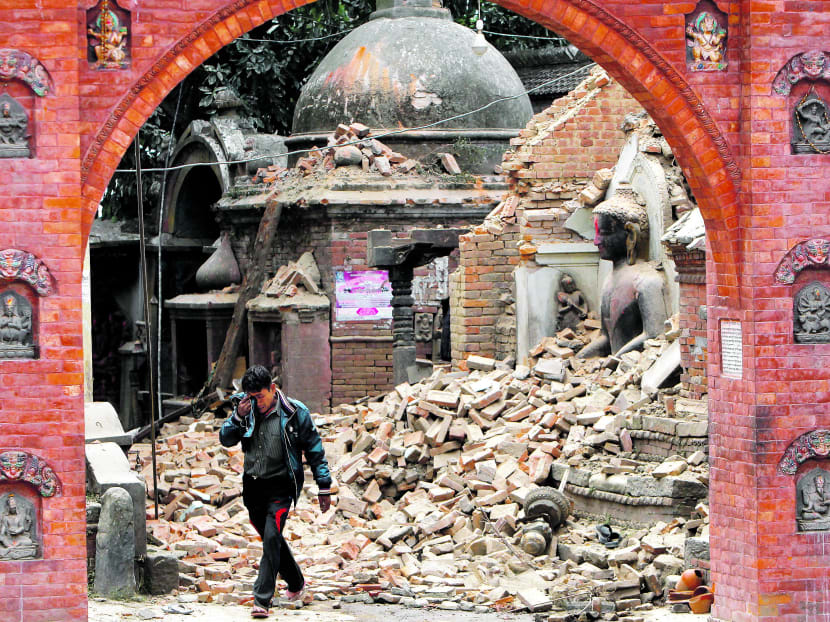Despair grips Nepal
KATHMANDU — Powerful aftershocks continued to convulse Nepal yesterday, making buildings sway and sending panicked Kathmandu residents screaming into the streets again and again a day after a devastating quake killed more than 2,500 people and injured about 5,800.

Bhaktapur, a UNESCO World Heritage Site near Kathmandu, lies in ruins yesterday, after a 7.8 earthquake on Saturday caused extensive damage and toppled walls and brought down buildings in Nepal. Photo: AP
KATHMANDU — Powerful aftershocks continued to convulse Nepal yesterday, making buildings sway and sending panicked Kathmandu residents screaming into the streets again and again a day after a devastating quake killed more than 2,500 people and injured about 5,800.
The magnitude 6.7 aftershock that pummelled the capital city early yesterday afternoon unleashed more avalanches in the Himalayas, where at least 18 people had already died and 61 injured on Saturday after a mass of snow, ice, and rocks buried part of a base camp.
As planeloads of supplies, doctors and relief workers from neighbouring countries began arriving in the country, bodies were piling up and rescuers dug with their bare hands in a desperate search for survivors.
Relief agencies said hospitals in the Kathmandu Valley were overflowing and running out of medical supplies.
Singapore yesterday (SUN) sent a 69-member search-and rescue team comprising officers from Singapore Civil Defence Force and Singapore Police Force to help with rescue and relief efforts.
The Republic has also pledged to disburse S$100,000 in seed money to kick start the Singapore Red Cross appeal for donations, while the Singapore Red Cross said it will be sending S$50,000 worth of relief items and emergency supplies to Nepal.
Saturday’s magnitude 7.8 earthquake spread horror from Kathmandu to small villages and to the slopes of Mount Everest. The earthquake was the worst to hit the South Asian nation in over 80 years and was strong enough to be felt across Asia by 100 million people, reported the United States Geological Survey, which displays more than 30 subsequent tremors in central Nepal. By yesterday, authorities said at least 2,200 people had died in Nepal alone, with 61 more deaths in India and a few in other neighbouring countries.
With search and rescue efforts far from over, the death toll is likely to soar.
“The aftershocks keep coming ... so people don’t know what to expect,” said Sanjay Karki, Nepal country head for global aid agency Mercy Corps.
“All the open spaces in Kathmandu are packed with people who are camping outdoors. When the aftershocks come you cannot imagine the fear. You can hear women and children crying.’’
The city was awash with rumours that the worst aftershocks were yet to come and with fears of greater destruction in the countryside, large swaths of which remained unreachable by phone.
Subhash Ghimire, editor in chief of the Nepalese newspaper República, said he managed to reach his father in his hometown village of 3,000 near the epicenter in the district of Gorkha. “He said not a single house is left in our village, including our own house,” Mr Ghimire said.
In Kathmandu, streets in parts of this city of about 1.2 million were impassable not so much from quake damage but because tens of thousands of people have taken up residence there.
It was a strategy endorsed by a government entirely overwhelmed by the enormity of the challenge facing the country best known for Everest.
Most areas across the country were without power and water. The United Nations said hospitals in the Kathmandu Valley were overcrowded, and running out of emergency supplies and space to store corpses. Plumes of smoke, meanwhile, rose above the capital as friends, relatives and others gathered by the river to quickly cremate loved ones’ remains.
The economy of Nepal, a nation of 27.8 million people, relies heavily on tourism, principally trekking and Himalayan mountain climbing.
Nepal’s existing political discord is likely to hamper rescue and rebuilding efforts. The government has been barely functional for more than a decade, with politicians of just about every stripe fighting over the scraps of the increasingly desperate economy.
Nepal’s people had already become exhausted with the political paralysis, but those feelings could turn explosive if relief and rescue efforts fail in the coming weeks, analysts said.
With Kathmandu airport reopened, the first aid flights began delivering aid supplies yesterday. The first to respond were Nepal’s neighbours _ India, China and Pakistan, all of which have been jockeying for influence over the landlocked nation.
Indian air force planes landed with 43 tons of relief material, including tents and food, and nearly 200 rescuers, India’s External Affairs Ministry spokesman Vikas Swarup said.
A 62-member Chinese search and rescue team also arrived, and other countries sending support included the United Arab Emirates, Germany, France, the United States, Pakistan and Israel.
On Mount Everest, helicopter rescue operations began to bring wounded climbers down off the mountain, where at least 18 climbers were killed and another 41 injured, making the earthquake the deadliest event in the mountain’s history.
But aftershocks and small avalanches continued to plague the nearly 800 people staying at the mountain base camp and at higher elevation camps throughout yesterday.
(AGENCIES)
Column: Pemba Sherpa, 43, a Mount Everest guide, was among the first group of survivors from Saturday’s avalanche flown in to Kathmandu.
``I was resting in my tent when the earthquake hit. I heard a big noise and the next thing I know I was swept away by the snow. I must have been swept almost 200 meters. I lost consciousness,” he said.
``When I regained consciousness, I was in a tent surrounded by foreigners. I did not know what happened or where I was.’’
He said the toll on Everest was sure to rise: ``There are still many people who are still missing on the mountain. There were several tents buried by the snow, several blown away.’’
(AGENCIES)






